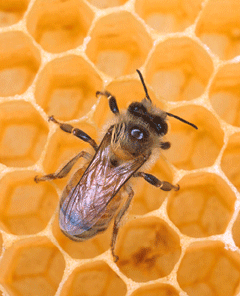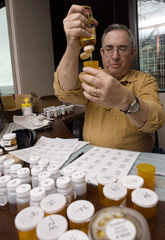Honey Laundering
Air Date: Week of January 30, 2009

A honeybee at work. (Photo: Scott Bauer, USDA/ARS)
The tale of honey is not all sweet. In an eight part investigative series in The Seattle Post-Intelligencer, reporter Andrew Schneider looks at the origins of imported honey and the lack of oversight by federal agencies. Schneider tells host Bruce Gellerman that Chinese honey makes up about a third of honey consumed in the U.S. and, he says, some of it is watered down with corn syrup and contains antibiotics illegal here.
Transcript
GELLERMAN: Americans have a sweet tooth for honey. We eat over a pound of honey per person a year. Honey is healthy and the stuff of sweet dreams - a major ingredient for Winnie the Pooh bedtime stories.
But just as Pooh got stuck digging deep in a honey pot, last spring West Coast importers got stung when a federal swat team swooped down and busted them for honey trafficking.
Andrew Schneider, a senior correspondent for the Seattle Post-Intelligencer, investigated honey imports. And his eight part series reads more like James Bond than Pooh Bear.

Andrew Schneider taking samples of honey for his investigative series for the Seattle Post Intelligencer. (Photo: Seattle Post Intelligencer)
GELLERMAN: So we’re consuming a lot. And a lot of that, you write, comes from China. I guess about half of the remaining imports.
SCHNEIDER: Yeah, that’s pretty much what we figured out. They’re most often marked as coming from other countries: Vietnam, Korea, India, Australia. But in most cases they are from China, and just illegally relabeled.
GELLERMAN: You have a great turn of a phrase – you call it honey laundering. And I guess the honey that we get from China is supposed to have a tariff. So what these companies do is they send it off to another country and label it coming from that country when it’s really coming from China.
SCHNEIDER: Right, you’ve defined honey laundering very well, Bruce. They avoid the tariffs by shipping it to a country that has no tariffs. And they also avoid the added scrutiny that’s often applied to Chinese honey, because Chinese honey has been found to be contaminated over the years with antibiotics that the FDA declares illegal.
GELLERMAN: When honey enters the United States from China or from any place else, isn’t it tested for safety?
SCHNEIDER: It depends who you ask. The closer that we got to the headquarters of FDA and the Immigration and Customs Enforcement Agency, the more people were insisting that they inspect every shipment of honey. But, Bruce, when you get to the field, when you get to the front lines, the ports, the Canadian borders, and talk to the people that are really assigned to do this, it’s just not happening. I mean, they just giggle at you. When we interviewed the head of the FDA program, a guy named Martin Stutsman, the headquarters was saying that we’re on top of this stuff. And Stutsman admitted that in the last year they’d actually inspected fewer than one hundred drums of honey. And hundreds of thousands of drums actually arrive each year.
GELLERMAN: Well what about the importers, the companies that actually, you know, purchase the honey in volume and then sell it over here. Don’t they test their own products?
SCHNEIDER: Not so much. Rarely, actually. One of the things that’s really gotta be understood is regardless of how sinister or criminal the Chinese honey shippers may be, they couldn’t get their honey into this country unless there were people here that were willing to close their eyes and make believe that it’s not from China. I mean, it’s pretty obvious. The going price for good honey, from Canada, for example, might be a buck sixty a pound. Australian honey might be a buck forty a pound. If all of a sudden, as a honey packer, you’re being offered three hundred thousand pounds of honey at fifty cents a pound, wouldn’t you think you might wonder a bit about why you’re getting such a great price.
GELLERMAN: Well we’ve been talking about honey, and one of the things you write about in your article is that actually, there is no legal definition of what honey is in this country. I mean, you could put another in a jar and call it honey?
SCHNEIDER: That’s correct. You can call it anything you want and you can put anything you want in the jar. And you can call it honey. Neither the FDA nor the USDA has a legal definition of honey. Which means that enforcing the quality of honey becomes extremely difficult and problematic. If it has a recognized hazardous or illegal substance like the antibiotics the Chinese use, then you can pull it off the market. But if it has any number of other things – like if it’s mixed with sugar water or corn syrup or something, there’s really nothing there in the regulations that say that “Thou shalt not do this.”
GELLERMAN: What about the labeling where it says organic?
SCHNEIDER: Well, if its says made in the U.S. organic honey, the chances are almost totally that they are wrong. Mainly because you can’t control where the bees fly. Now that doesn’t mean there isn’t organic honey. There are parts of South America that are totally undeveloped. There are parts of Northern Canada that have no commercial farming whatsoever, and there is organic honey coming from those places, but if it says made in the U.S.A. organic, I’d be very suspicious of it.

(Photo: Scott Bauer, USDA/ARS)
SCHNEIDER: I liked it a lot more before I started researching this story.
GELLERMAN: Investigative reporter Andrew Schneider’s eight part series about imported honey appears in the Seattle Post Intelligencer. We contacted Martin Stutsman of the Food and Drug Administration and he confirmed the government does test only about 100 barrels of imported honey a year.
STUTSMAN: Honey is a low risk commodity. We don’t have a lot of problems with honey.
GELLERMAN: Why is there no legal definition of honey. I understand that you can actually put sugar water or fructose in a plastic bear and call it honey because there is no regulation.
STUTSMAN: We don’t have a regulation specifying what honey is. But honey is commonly understood to be the material produced by bees from nectar of flowers and deposited and dehydrated by the bees in the honeycomb.
GELLERMAN: And Martin Stutsman says the FDA has and does cite packagers who mix fructose with honey.
[MUSIC: Emily Remler “A Taste OF Honey” from Firefly (Concord Records 2000)]
GELLERMAN: Just ahead: dancing bears in Bulgaria. Stay tuned to Living on Earth.
ANNOUNCER: Support for the Environmental Health Desk at Living on Earth comes from the Cedar Tree Foundation. Support also comes from the Richard and Rhoda Goldman fund for coverage of population and the environment. And from Gilman Ordway for coverage of conservation and environmental change. This is Living on Earth on PRI, Public Radio International.
Links
Living on Earth wants to hear from you!
Living on Earth
62 Calef Highway, Suite 212
Lee, NH 03861
Telephone: 617-287-4121
E-mail: comments@loe.org
Newsletter [Click here]
Donate to Living on Earth!
Living on Earth is an independent media program and relies entirely on contributions from listeners and institutions supporting public service. Please donate now to preserve an independent environmental voice.
NewsletterLiving on Earth offers a weekly delivery of the show's rundown to your mailbox. Sign up for our newsletter today!
 Sailors For The Sea: Be the change you want to sea.
Sailors For The Sea: Be the change you want to sea.
 The Grantham Foundation for the Protection of the Environment: Committed to protecting and improving the health of the global environment.
The Grantham Foundation for the Protection of the Environment: Committed to protecting and improving the health of the global environment.
 Contribute to Living on Earth and receive, as our gift to you, an archival print of one of Mark Seth Lender's extraordinary wildlife photographs. Follow the link to see Mark's current collection of photographs.
Contribute to Living on Earth and receive, as our gift to you, an archival print of one of Mark Seth Lender's extraordinary wildlife photographs. Follow the link to see Mark's current collection of photographs.
 Buy a signed copy of Mark Seth Lender's book Smeagull the Seagull & support Living on Earth
Buy a signed copy of Mark Seth Lender's book Smeagull the Seagull & support Living on Earth

